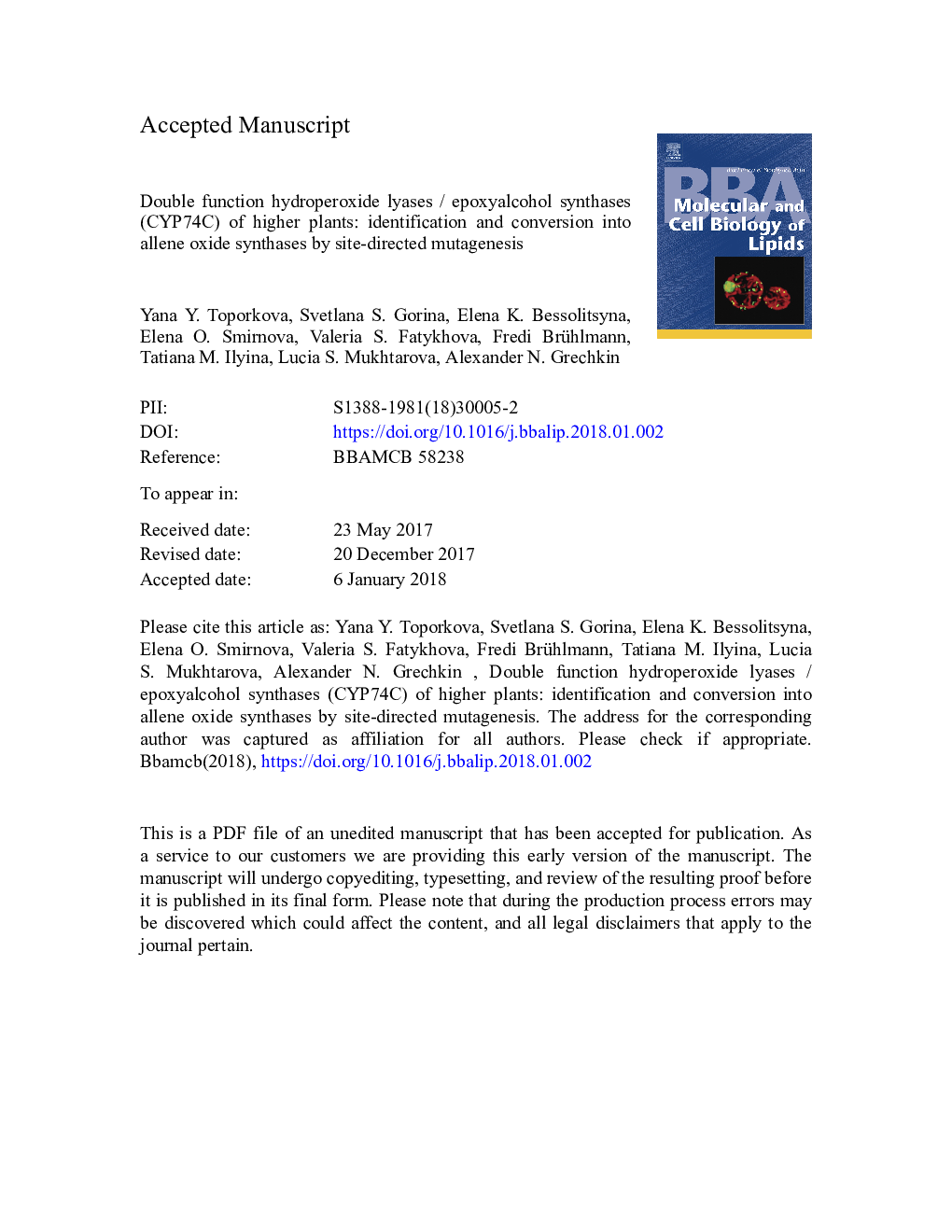| Article ID | Journal | Published Year | Pages | File Type |
|---|---|---|---|---|
| 8301361 | Biochimica et Biophysica Acta (BBA) - Molecular and Cell Biology of Lipids | 2018 | 38 Pages |
Abstract
The CYP74C subfamily of fatty acid hydroperoxide transforming enzymes includes hydroperoxide lyases (HPLs) and allene oxide synthases (AOSs). This work reports a new facet of the putative CYP74C HPLs. Initially, we found that the recombinant CYP74C13_MT (Medicago truncatula) behaved predominantly as the epoxyalcohol synthase (EAS) towards the 9(S)-hydroperoxide of linoleic acid. At the same time, the CYP74C13_MT mostly possessed the HPL activity towards the 13(S)-hydroperoxides of linoleic and α-linolenic acids. To verify whether this dualistic behaviour of CYP74C13_MT is occasional or typical, we also examined five similar putative HPLs (CYP74C). These were CYP74C4_ST (Solanum tuberosum), CYP74C2 (Cucumis melo), CYP74C1_CS and CYP74C31 (both of Cucumis sativus), and CYP74C13_GM (Glycine max). All tested enzymes behaved predominantly as EAS toward 9-hydroperoxide of linoleic acid. Oxiranyl carbinols such as (9S,10S,11S,12Z)-9,10-epoxy-11-hydroxy-12-octadecenoic acids were the major EAS products. Besides, the CYP74C31 possessed an additional minor 9-AOS activity. The mutant forms of CYP74C13_MT, CYP74C1_CS, and CYP74C31 with substitutions at the catalytically essential domains, namely the “hydroperoxide-binding domain” (I-helix), or the SRS-1 domain near the N-terminus, showed strong AOS activity. These HPLs to AOSs conversions were observed for the first time. Until now a large part of CYP74C enzymes has been considered as 9/13-HPLs. Notwithstanding, these results show that all studied putative CYP74C HPLs are in fact the versatile HPL/EASs that can be effortlessly mutated into specific AOSs.
Keywords
TICTMSOxylipins9-H(P)OD(9S,10E,12Z)-9-hydro(pero)xy-10,12-octadecadienoic acidtrimethylsilylHSQCEASIMACHPL13-H(P)OD(9Z,11E,13S)-13-hydro(pero)xy-9,11-octadecadienoic acidSite-directed mutagenesisDESAOStotal ion currentDivinyl ether synthaseEpoxyalcohol synthaseAllene oxide synthaseCytochrome P450SIMHeteronuclear single quantum coherence spectroscopycorrelation spectroscopyheteronuclear multiple-bond correlation spectroscopyMethylselected ion monitoringHMBC یا Heteronuclear Multiple Bond CorrelationHydroperoxide lyaseCOSYImmobilised metal affinity chromatography
Related Topics
Life Sciences
Biochemistry, Genetics and Molecular Biology
Biochemistry
Authors
Yana Y. Toporkova, Svetlana S. Gorina, Elena K. Bessolitsyna, Elena O. Smirnova, Valeria S. Fatykhova, Fredi Brühlmann, Tatiana M. Ilyina, Lucia S. Mukhtarova, Alexander N. Grechkin,
